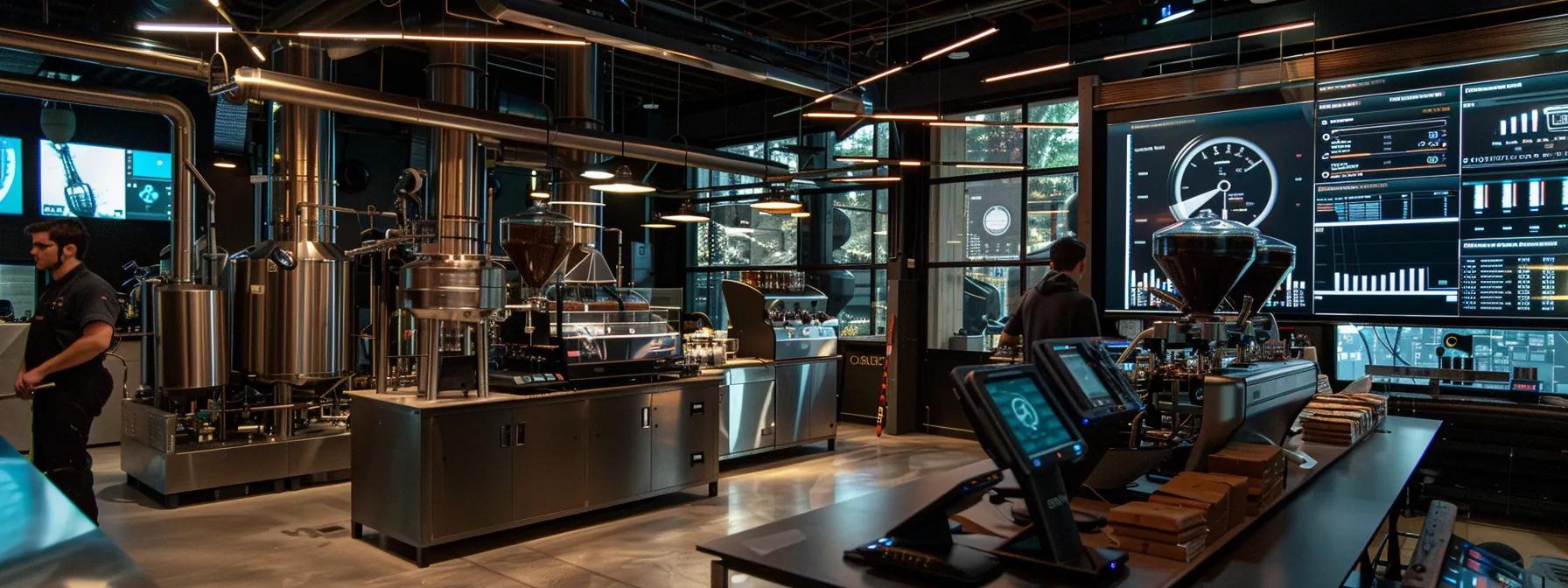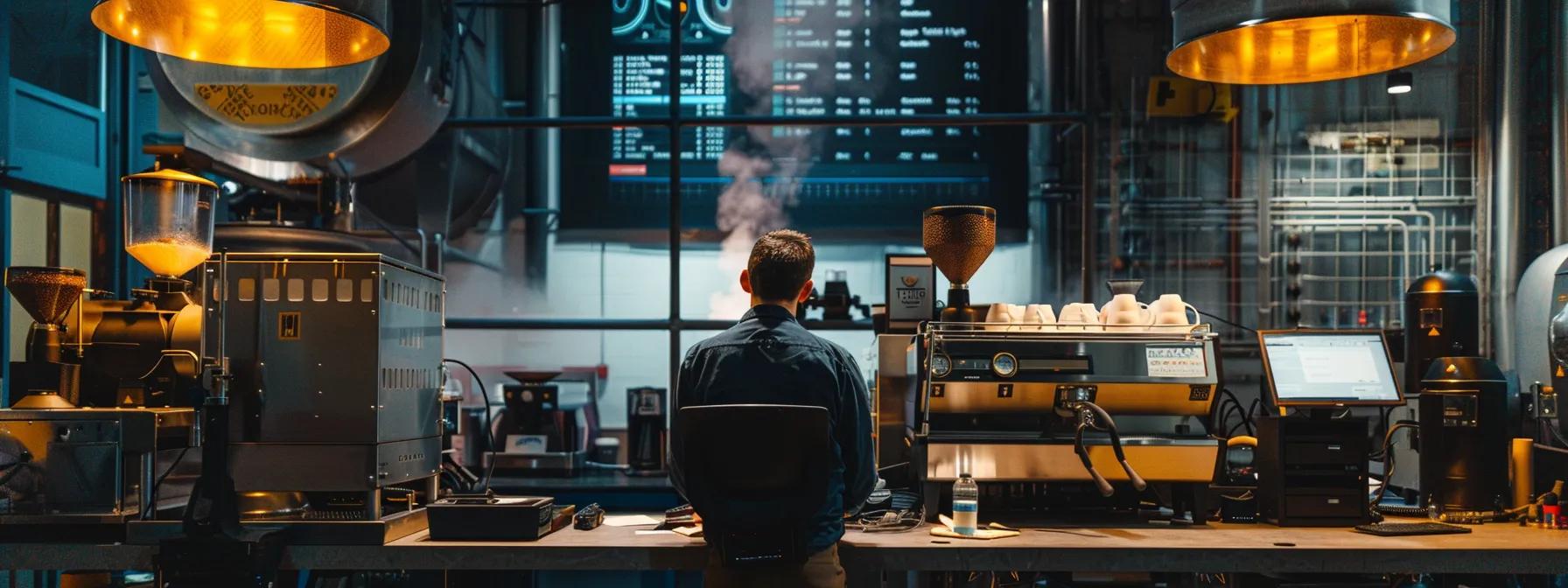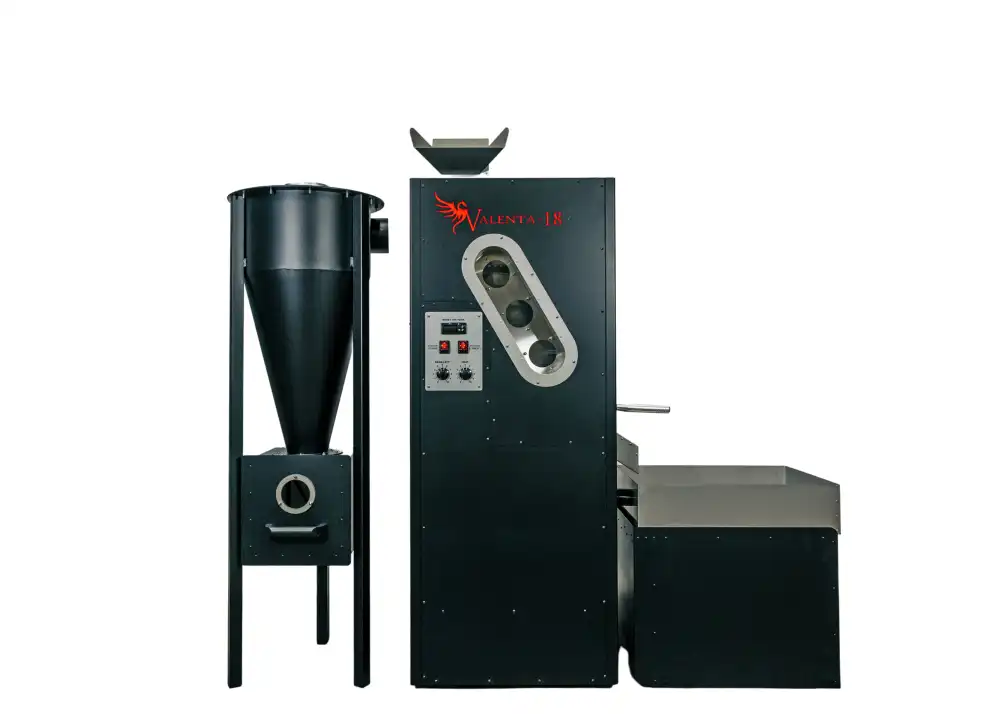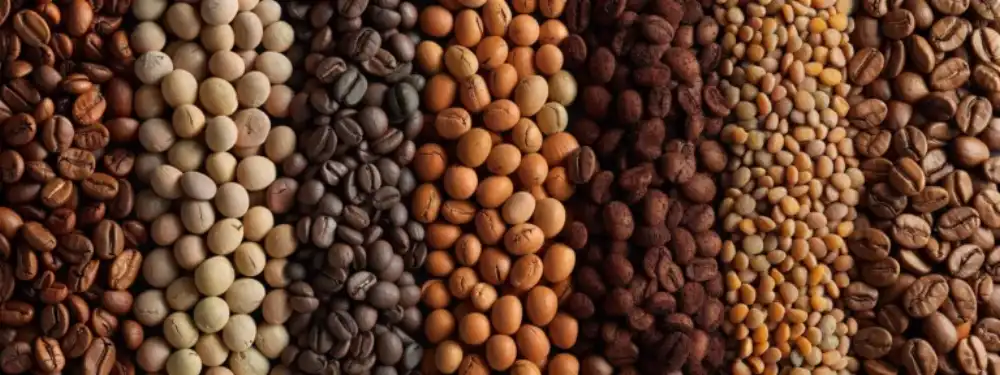Table Of Contents:
- What Is ROI in Coffee Roasting and Why Does It Matter?
- How Does the Coffee Roasting ROI Calculator Work?
- What Are the Key Costs in Coffee Roasting That Impact ROI?
- How Can Coffee Roasters Optimize Their ROI for Better Profitability?
- What Are Real-World Examples of Successful Coffee Roasting ROI Improvements?
- How Can Coffee Roasters Calculate and Track ROI Over Time?
- Where Can Coffee Roasters Access Educational Resources to Improve ROI?
- Frequently Asked Questions
- Final Thoughts
Coffee roasting is both an art and a science, where every decision—from choosing the right green beans to optimizing the roast profile—affects profitability. For many small-scale and home-based coffee roasters, understanding the return on investment (ROI) is critical. This article explains how to calculate ROI, the factors affecting it, and strategies to optimize it. By integrating data-informed insights with industry best practices, this guide empowers coffee crafters to boost profitability. Let’s explore coffee roasting ROI, learn to integrate specialized calculators into your operations, and review real-world examples of successful ROI improvements.
What Is ROI in Coffee Roasting and Why Does It Matter?
ROI in coffee roasting measures the profitability of your operations relative to the investment made. In simple terms, it shows the dollar return for every dollar spent. A solid ROI indicates that a business is not only surviving but also growing in revenue and market share. It guides roasters to adjust pricing, reallocate resources, or improve quality to attract more customers. Check out our own Coffee Roasting Calculator:
ROI influences decisions from selecting the right roasting equipment (fluid bed or drum roasters) to planning operational upgrades. It links material costs, labor, overhead, and revenue from retail or wholesale channels. A robust ROI reflects a sound balance sheet despite fluctuating green coffee prices and changing consumer tastes.
How Is ROI Calculated for Coffee Roasting Businesses?
ROI is calculated using the formula: ROI = (Net Profit / Total Investment) x 100
Net Profit is the difference between total revenue and total costs. Total Investment includes costs from equipment expenses to operational and sourcing costs. Gather data such as revenue per roasted batch, green coffee bean costs, energy consumption, and labor rates to compute an accurate ROI. For instance, if annual revenue is $150,000 and total costs are $100,000, the ROI would be 50%, meaning each dollar invested returns an extra 50 cents. Such figures help roasters decide if their efforts are sustainable or if they should invest in upgrades like a more sophisticated fluid bed roaster.
What Are the Main Cost Factors Affecting Coffee Roasting ROI?
Key cost factors include:
- Green Coffee Beans: These usually form the largest cost, with price fluctuations significantly impacting margins.
- Energy Costs: Different roaster types, such as drum and fluid bed, have varying energy profiles that affect overall costs.
- Labor and Maintenance: Staffing, training, and equipment upkeep affect productivity and efficiency.
- Packaging and Distribution: The costs associated with packaging supplies and logistics also play a vital role.
Efficient management of these factors is essential to reduce overhead and improve net profit.
What Is a Good ROI Benchmark for Coffee Roasters?
Successful small-scale roasters often target an ROI between 20% to 50%. Achieving ROI within this range suggests that cost controls are effective and market positioning is strong. An ROI below 20% may indicate the need to restructure operations, manage overheads, or renegotiate supplier agreements. Regular monitoring using advanced calculators is recommended to sustain and improve ROI over time.
How Does the Coffee Roasting ROI Calculator Work?
The ROI calculator integrates cost and revenue components into one platform. By inputting key variables like green coffee cost, roast yield, operational expenses, and sales prices, it computes net profit and ROI automatically. This tool provides a snapshot of current performance as well as predictive insights into future scenarios.

What Inputs Are Needed to Use the ROI Calculator Effectively?
You must input accurate and up-to-date financial and operational data, including:
- Green Coffee Cost: Price per pound or kilo of unroasted beans.
- Roasting Yield: The percentage of weight loss during roasting.
- Operational Costs: Expenses for energy and labor.
- Equipment Costs: Purchase, maintenance, and depreciation expenses.
- Sales Price: The price at which the roasted coffee sells.
- Packaging and Distribution Costs: Expenses related to packaging and logistics.
Accurate inputs ensure the calculator reflects current conditions, enabling better strategic planning.
How Does the Calculator Provide Actionable Insights?
After processing inputs, the calculator generates metrics such as net profit, profit margins, and ROI percentage, often accompanied by graphical data identifying cost centers. It may suggest improvements like adjusting roast yield or sourcing more cost-effective green coffee. Such insights allow roasters to make informed decisions both immediately and for long-term growth.
How Can Roasters Integrate the Calculator With Their Business Tools?
Modern ROI calculators sync with business tools like point-of-sale systems, inventory management, and accounting software. Real-time data synchronization means adjustments in sales or supply costs are automatically reflected, reducing errors and saving time while supporting agile business decisions.
What Are the Key Costs in Coffee Roasting That Impact ROI?
Every expense from the roasting process affects profitability and ROI. Managing these costs efficiently is key to maintaining competitive margins.
How Do Green Coffee Costs Influence Profitability?
Green coffee is often the largest expense. Securing a reliable, high-quality supply at competitive prices is crucial. Even small cost reductions can result in substantial savings when processed in volume. Many roasters use forward contracts or negotiate long-term deals to stabilize costs and ensure quality.
What Are the Typical Roasting and Labor Costs?
Roasting costs cover energy consumption, machine maintenance, and calibration of roasters. Fluid bed roasters may use energy more efficiently than drum roasters, though the latter might deliver more consistent roasts. Additionally, labor costs encompass wages and the expertise needed to fine-tune roasting profiles. Reducing energy waste and investing in efficient technology and training can significantly improve ROI.
How Do Packaging and Distribution Costs Affect Margins?
Packaging and distribution costs encompass bags, labeling, sealing, transportation, and retailer margins. Choosing premium packaging enhances brand image but can also drive up costs. Roasters can optimize margins by selecting eco-friendly packaging, negotiating volume discounts, or selling directly online to reduce intermediary expenses.
How Can Coffee Roasters Optimize Their ROI for Better Profitability?
Optimizing ROI involves several strategies that improve both revenue and efficiency.

What Pricing Strategies Maximize Coffee Roasting Profits?
Strategic pricing is a powerful tool for improving ROI. A tiered-pricing strategy allows roasters to cater to different market segments by offering artisanal small batches at higher margins while keeping larger wholesale prices competitive. Dynamic pricing models that account for demand, seasonality, and production costs can further enhance profitability.
How Can Roasting Yield Be Improved to Boost ROI?
Improving roasting yield—minimizing the weight loss during roasting—means more sellable product per batch. This can be achieved by fine-tuning machine parameters (temperature, airflow, roast duration) and investing in modern roasters with advanced sensors. Routine maintenance and equipment calibration are also essential, reducing production costs and reinforcing ROI.
How Does Sourcing High-Quality, Cost-Effective Green Coffee Help?
High-quality green coffee not only supports a premium product but also allows for higher pricing. Sourcing strategies that focus on cost-effectiveness—such as building strong supplier relationships, negotiating bulk purchasing contracts, or engaging in direct trade—can lead to discounts and enhanced consistency, directly boosting ROI.
What Sales Channels Drive Higher Returns for Coffee Roasters?
Diversified sales channels help maximize ROI by spreading risk. Direct-to-consumer sales through online stores or subscription models typically offer higher margins by cutting out intermediaries. Partnerships with specialty coffee shops and gourmet retailers can further enhance brand visibility and secure stable distribution, leading to increased profitability.
What Are Real-World Examples of Successful Coffee Roasting ROI Improvements?
Real-world examples show that strategic adjustments yield considerable ROI improvements. For instance, one micro-roastery used an ROI calculator to analyze energy use during different roast cycles. By adjusting their roast profiles and optimizing machine performance, they reduced energy costs by 15% over six months and improved overall ROI by nearly 30%.
How Have Coffee Roasters Increased ROI Using the Calculator?
Several roasters have leveraged ROI calculators to identify and remedy inefficiencies. Data-driven insights allowed one roastery to renegotiate supplier contracts and optimize labor allocation, demonstrating the practical benefits of regular ROI analysis.
What Strategies Have Proven Effective in Coffee Roasting Businesses?
Key strategies include:
- Process Optimization: Adjusting roast settings and schedules to reduce energy and labor costs.
- Supplier Negotiations: Securing better contracts for green beans to reduce input costs.
- Product Diversification: Offering a range of roast profiles and seasonal blends to attract broader customers.
- Technology Integration: Using automated roasters and modern sensors to minimize waste and ensure consistency.
- Direct Sales Channels: Focusing on online sales to increase profit margins by avoiding intermediary fees.
These strategies help build resilient businesses that adapt to industry changes.
How Can Coffee Roasters Calculate and Track ROI Over Time?
Sustained success requires continuous monitoring and adjustment of ROI. A systematic tracking approach helps roasters evaluate the impact of process improvements, market fluctuations, and technology upgrades on performance.

What Metrics Should Be Monitored Regularly?
Key metrics to monitor include:
- Net Profit Margin: Overall profitability after all expenses.
- Cost per Pound: Expense of converting green coffee into roasted coffee.
- Yield Percentage: Rate of conversion from raw to roasted beans.
- Energy Consumption: Energy used per roast cycle.
- Labor Costs: Efficiency of workforce relative to output.
- Sales Volume and Average Selling Price: Trends reflecting revenue generation.
Regular monitoring allows for prompt adjustments when deviations occur.
How Does Continuous ROI Tracking Support Business Growth?
Continuous ROI tracking provides a feedback loop for validating business strategies. Monthly or quarterly reviews help assess the effectiveness of pricing adjustments, process improvements, and supply chain changes, which in turn guide better forecasting, budgeting, and investment decisions.
What Tools Complement the ROI Calculator for Better Analysis?
Integrating ROI calculators with inventory management, accounting, and CRM systems can provide granular insights into operational performance. An integrated dashboard displaying real-time data on inventory turnover, supplier performance, and sales trends helps refine ROI projections and supports immediate corrective actions for sustained profitability.
Where Can Coffee Roasters Access Educational Resources to Improve ROI?
A wealth of educational resources is available to help coffee roasters enhance their business performance from our coffee news resource center. High-quality guides, tutorials, webinars, and case studies offer practical advice and strategies to improve ROI.
What Guides and Tutorials Help Understand Coffee Roasting ROI?
Our comprehensive online guides and video tutorials explain the fundamentals of ROI calculation and advanced strategies for optimizing roasting processes. These resources often include real-life examples and benchmarking exercises, providing actionable insights from industry experts who have scaled their roaster operations successfully.
How Do Webinars and Case Studies Enhance ROI Knowledge?
Interactive webinars allow roasters to learn directly from experienced practitioners and gain immediate answers to everyday challenges. Detailed case studies highlight how specific changes in sourcing, roasting efficiency, or sales strategies have transformed operations and improved ROI, offering valuable lessons in avoiding common pitfalls.
Where to Find Templates and Tools for Coffee Roasting Business Management?
Digital tools such as financial spreadsheets, ROI calculators, inventory management templates, and scheduling tools are available on various industry websites and forums. You may also want to try Gemini from Google to help you. These resources simplify complex business functions and can be customized to meet unique operational needs, directly contributing to improved cost management and ROI.
Frequently Asked Questions
Q: What is the ROI calculator for coffee roasting? A: It is a digital tool that aggregates cost inputs (green coffee, energy, labor, packaging) and revenue data to compute the return on investment, providing a clear percentage that reflects profitability and guides operational improvements.
Q: How often should I update the inputs in my ROI calculator? A: For accuracy, update the inputs monthly or quarterly to track fluctuations in coffee prices, energy costs, and sales performance.
Q: Can the ROI calculator help me decide whether to invest in a more efficient roaster? A: Yes. By comparing savings from reduced energy use and improved yields against the investment cost, the calculator helps determine if an upgrade will lead to a higher ROI.
Q: What are some common challenges in achieving a high ROI in coffee roasting? A: Challenges include fluctuating green coffee prices, energy inefficiencies, high labor costs, and market volatility. An ROI calculator helps identify these issues and suggests areas for improvement.
Q: How do sales channels affect the ROI in coffee roasting? A: Direct-to-consumer platforms typically offer higher margins than wholesale. Diversifying sales channels can reduce intermediary costs and improve overall profitability.
Q: Are there any free resources available to improve my coffee roasting business management? A: Yes, many online guides, webinars, and downloadable templates are available on industry forums and websites covering topics from ROI calculation to overall operational optimization.
Q: How can I integrate my ROI calculator with other business tools? A: Many modern ROI calculators integrate with accounting software, CRM systems, and inventory management tools, enabling automatic updates and real-time performance monitoring.

Final Thoughts
ROI is a critical measure for every coffee roaster to understand profitability and maintain a competitive edge. By leveraging a comprehensive ROI calculator, you can break down major cost drivers, streamline operational efficiencies, and adapt to market changes. Embracing data-informed strategies—from optimizing green coffee costs to integrating automated tools—leads to sustained business growth and smarter returns in the dynamic world of coffee roasting.









